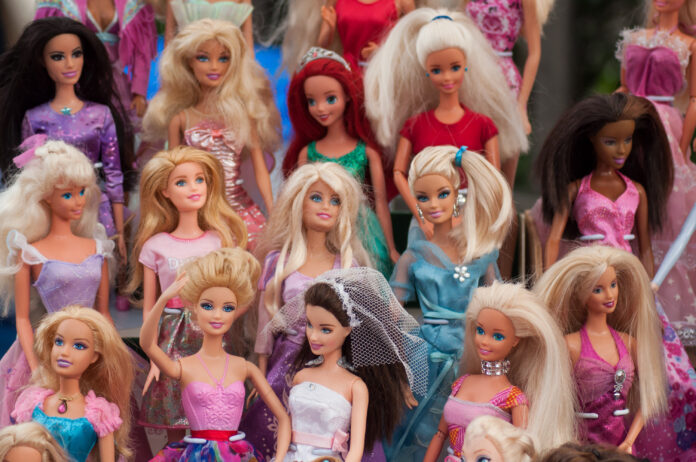In the early 1970s, Mattel partnered with United Airlines to enter Barbie into one of her many careers.
They packaged a replica of the bold colored, brightly-patterned flight attendant’s outfit of the time for Barbie and a more demure gray pilot’s outfit for Ken. Capping off the collection was a plastic-over-stiff cardboard airplane playset called the Barbie Friend Ship.
I was busy scheming. During Christmas, I spotted this in the Sears “wish book” of holiday toys, trying to figure out the best way to put this on the list for Santa — and my parents — that year. I decided to sneak it — with a Barbie and the flight attendant outfit, of course — on the bottom third of the list, assuming it would not draw so much attention that far down.
Even then, I had a strong suspicion I should not have been asking for Barbies. None of the boys I knew had any, and as everyone assumed I was a boy, I knew the toy request was more than a long shot. Rather, I tended to be given the “Big Jim” dolls, which were the alternative that Mattel packaged up for boys, and who often used the very same playlets and objects as Barbie.
In fact, I did eventually end up with the “Friend Ship” in its repackaged-for-Big-Jim-variety, called the “Sky Commander.” It wasn’t quite what I’d hoped for.
Even as a fairly young child, I knew what I wanted: her name was Barbie. While this wasn’t my first memory that shows a distinct identification with other girls and women, it’s close.
Let’s not forget, however, that Barbie is a doll that was initially patterned after a German adult doll named Bild Lilli that sold for the male gaze versus the early tween girl market. Barbie has rightfully been critiqued over the years in presenting itself as being subservient to her biggest accessory, the Ken doll, and focusing on traditional, white, cisheteronormative social mores.

Barbie herself has gone through a lot since her beginnings, replacing her flight attendant gear for a role in the captain’s seat. She’s been a member of the military, a rapper, a doctor, a member of Starfleet, and even a presidential candidate. Now, she is the subject of a movie directed by Greta Gerwig, and starring Margot Robbie and Ryan Gosling.
I don’t want to spend a lot of time rehashing and reviewing the movie. It’s a box-office smash, on track as of this writing to top $1 billion in ticket sales. It’s worth it, too.
It’s a film that is self-aware of the doll’s history, as well as the critiques, and Gerwig deftly creates a movie about Barbie and Ken that doesn’t entirely shy away from examining feminism and feminist ideas.
Gerwig, I feel like noting, was also initially disallowed Barbie dolls as a young girl. She spoke on this to The New York Times, where she discussed the controversies around the doll, how those touched her own life, and then opting to make a film where she could be “doing the thing and subverting the thing.” It makes the film somewhat unique in both celebrating the consumerist, plastic, and pink world that is Barbie, while being very clear on its critiques of the same.
If nothing, the movie maybe could have gone further — but in doing so, it also may have lost some of the charm, and some of the draw.
You will see Barbies of color in the movie, and Barbies who are not waif thin, nor exceptionally busty. You will see Barbies in a number of their high-profile positions, including president, physicist, Supreme Court justice and doctor.
Let me note that Dr. Barbie is played by a trans woman, Hari Nef.
I feel it noteworthy that Nef did not play this character as “Trans Woman Barbie” and, in fact, there is nothing in the film that draws attention to her trans nature. You won’t find a sly trans flag motif snuck in, nor any other blink-or-you’ll-miss-it trans references surrounding the character. She is just another Barbie, even if she is one of Robbie’s closer friends as portrayed in the movie.
Yes, I’m happy with this. I don’t feel the need to see Nef have to play a very distinctly transgender Barbie in the movie. Her just being part of the cast of dolls is plenty. In fact, I might even say it’s better this way, as she is simply another one of the women who make up this cast — and in a year where being trans has served as a reason to attack beer companies and major retailers, it is refreshing to see a trans voice just, well, existing with her peers.
This, of course, hasn’t stopped bigots from learning that there is a trans woman in the movie, nor has it stopped their attacks. It has, however, led to many humorous moments on social media as they continually try, and fail, to determine which Barbie was played by a trans woman in the first place.
That, too, may go a long way toward explaining why she didn’t need to be specifically called out in the movie as being a trans woman, and even reinforces one of the main themes of the tale: “just be yourself and know that that’s enough.”
So it is, Barbie. So it is.
Gwen Smith never did get that Barbie, and she’s okay with that. You’ll find her at www.gwensmith.com
